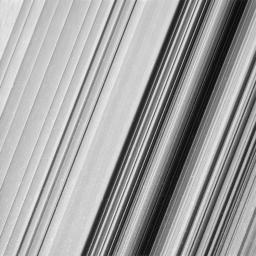
|
Saturn’s B Ring, Finer Than Ever
- Click the image above for a larger view
- Full-Res JPEG (1020 x 1020) (210.1 kB)
- Full-Res TIFF (1020 x 1020) (1.0 MB)
Caption:
This image shows a region in Saturn's outer B ring. NASA's Cassini spacecraft viewed this area at a level of detail twice as high as it had ever been observed before. And from this view, it is clear that there are still finer details to uncover.
Researchers have yet to determine what generated the rich structure seen in this view, but they hope detailed images like this will help them unravel the mystery.
In order to preserve the finest details, this image has not been processed to remove the many small bright blemishes, which are created by cosmic rays and charged particle radiation near the planet.
The image was taken in visible light with the Cassini spacecraft wide-angle camera on Dec. 18, 2016. The view was obtained at a distance of approximately 32,000 miles (51,000 kilometers) from the rings, and looks toward the unilluminated side of the rings. Image scale is about a quarter-mile (360 meters) per pixel.
Background Info:
The Cassini mission is a cooperative project of NASA, ESA (the European Space Agency) and the Italian Space Agency. The Jet Propulsion Laboratory, a division of the California Institute of Technology in Pasadena, manages the mission for NASA's Science Mission Directorate, Washington. The Cassini orbiter and its two onboard cameras were designed, developed and assembled at JPL. The imaging operations center is based at the Space Science Institute in Boulder, Colorado.
For more information about the Cassini-Huygens mission visit http://saturn.jpl.nasa.gov and http://www.nasa.gov/cassini . The Cassini imaging team homepage is at http://ciclops.org .
Cataloging Keywords:
| Name | Value | Additional Values |
|---|---|---|
| Target | Saturn Rings | B Ring |
| System | Saturn | |
| Target Type | Ring | |
| Mission | Cassini-Huygens | |
| Instrument Host | Cassini Orbiter | |
| Host Type | Orbiter | |
| Instrument | Imaging Science Subsystem (ISS) | |
| Detector | Wide Angle Camera | |
| Extra Keywords | Disk, Grayscale, Visual | |
| Acquisition Date | ||
| Release Date | 2017-01-30 | |
| Date in Caption | 2016-12-18 | |
| Image Credit | NASA/JPL-Caltech/Space Science Institute | |
| Source | photojournal.jpl.nasa.gov/catalog/PIA21058 | |
| Identifier | PIA21058 | |
